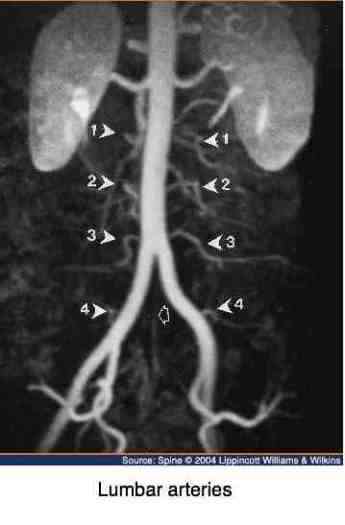Atherosclerosis symptoms and low back pain
Atherosclerosis Symptoms and Low Back Pain research throw up some interesting facts.
LBP research indicates there is a close association between vascular disease and lumbar disc degeneration.
Every chiropractor knows that managing the smoker suffering from a disc injury is more demanding, and the likelihood of failure of conservative treatment is greater. Likewise it has been identified as the greatest risk factor in lumbar surgery.
Various reasons have been promulgated for this baffling phenomenon. Most relate to decreased oxygenation of damaged lumbar tissue in the various phases of healing, but repeated coughing is thought to be a factor too. There are almost certainly others also.
Four paired arteries and the middle sacral vessel feed the
lumbar spine. Aortic calcification at the junction is
thought to be the cause of atherosclerosis symptoms low back pain; together with the build up of fatty plaque.

Atherosclerosis symptoms and low back pain
It has been postulated that a diminished supply of blood to the lumbar spine could result in a variety of back conditions.
Kauppila and colleagues did a systematic search of the research literature looking for an association between atherosclerosis, lower back pain and degenerative disc disease to test the validity of such a link. Twenty-five suitable papers were found.
Results
- Post mortem studies showed a connection between:
- Damaged inner lining of the arteries and degenerative joint disease.
- Lumbar artery blockage and a history of chronic lower back pain.
- Clinical studies revealed:
- Calcification of the arteries is associated with lower back pain.
- Lumbar arterial stenosis is associated with both degenerative disc disease and lower back pain.
- Epidemiological studies revealed a consistent association of degenerative lower back pain with:
- Smoking.
- Raised cholesterol.
Their conclusions were that stenosis of the aorta and the feeding arteries of the lumbar spine
were associated with degenerative disc disease and lower back pain; caused by atherosclerosis.
Damage to the inner lining of the artery, called the intima, is a deadly disease. The best cure is prevention. However there is much to be done once atherosclerosis has begun.
First you must get your cholesterol down if it is raised. The easiest is to eat certain fibre-rich foods; and the most delicious you can get are from this eggplant recipes link.
Some unknown substance in brinjals, as we call them, known in Europe as aubergine, has been proved to lower the bad fraction of cholesterol.
Secondly a glass of red wine is a helper; read more from these cholesterol alcohol links. The omega 3 in fatty fish, and olive oil are also known anti-inflammatories of vascular disease.
Butyrate
Butyrate is one of the short-chain fatty acids produced by the bacteria in the happy tum. It is a powerful anti-inflammatory agent blocking certain noxious enzymes that attack the mucosa[1].
More it travels far beyond the gut via the enteric nervous system, helping to prevent the cytokine storms, generalised inflammation that can kill so quickly, particular in the brain and lungs.
This inflammation is also an underlying cause of damage to the inner lining of the blood vessels; atherosclerosis symptoms and low back pain are well described in the literature.
The happy tum is dependent on two independent factors.
- A diet rich in diverse, fermented probiotic foods.
- Plenty of fibre from our food that this normal flora feed on.
Researchers have shown that pectin, the soluble fibre found in fruit is the most effective nutrient in supporting these friendly bacterial, viruses and yeast cells; again confirming why apples have such a powerful effect in lowering LDL cholesterol.
Homocysteine
In the absence of a diet rich in certain minerals and vitamins, a very toxic, inflammatory amino acid, homocysteine, builds up in body.
Homocysteine cardiovascular effects are particularly noxious as inflammation occurs in the blood vessels increasing the risk of stroke, heart disease and in particular in this instance episodes of low back pain.
Which vitamins and minerals you may be asking? Broccoli facts make interesting reading. She is not queen of the dark-green leafy vegetables for nothing.
Leg pain
There are many causes of leg pain obviously. These are a few of the more common causes that you might like to consider.
Arthritis in lower back
Lower back pain in the elderly is an anathema, a complex syndrome
related to old injury, tissues starved of oxygen for one reason or
another. Immobilisation Arthritis is a condition where cartilage degenerates in an environment where the joints are chronically fixated.
Poor diet, smoking and lack of exercise all contribute; so does a leg length deficiency or short limb causing a scoliosis; the causes are legend.
Despite all this, there is strong research that manipulation and mobilisation is what really helps lower
back pain, even chronic LBP in the elderly. Even when there
is advanced arthritis in the lumbar spine there is plenty to be achieved with chiropractic help, including a disciplined set of daily exercises.
Stop smoking permanently
This little book by Allen Carr is a winner. His success story could be yours too.
- STOP SMOKING PERMANENTLY by Allen Carr.
- Home
- SLIPPED DISC
- Atherosclerosis Symptoms and Low Back Pain
Did you find this page useful? Then perhaps forward it to a suffering friend. Better still, Tweet or Face Book it.
